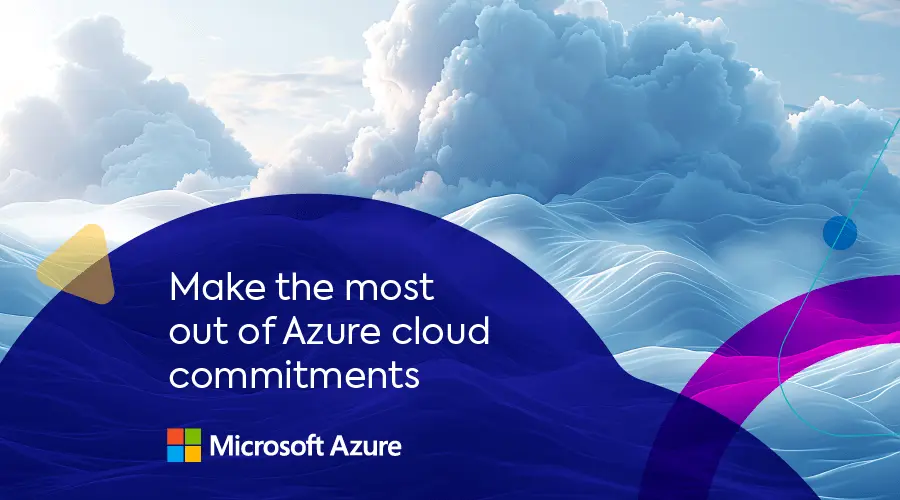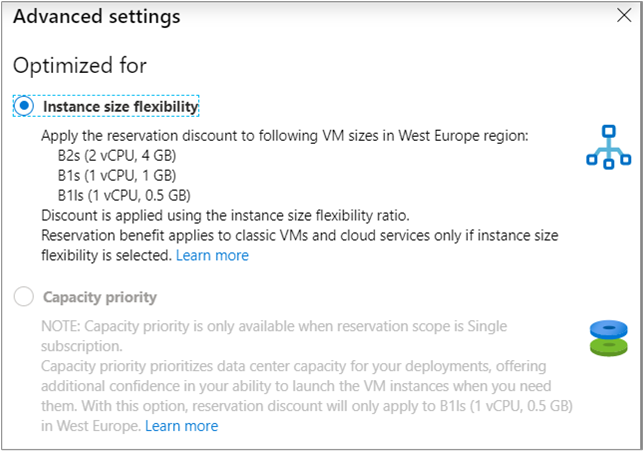
In the landscape of cloud cost optimization, Azure’s discounted Reservations and Savings Plans stand out for their flexibility. On June 6th, 2024 Azure postponed its decision to limit reservation exchanges on its major compute services for an unlimited “grace period”. As a result, commitments on all of Azure’s compute and other services remain highly flexible to modify or exchange.
Let’s explore the key aspects of this flexibility, and how to best tap into Azure’s commitment savings potential.
The flexibility of Azure Reserved VM Instances (RIs)
Azure’s RIs promise up to 72% cost savings compared to pay-as-you-go rates, in exchange for upfront commitments on compute capacity for one or three years. Here are the changes allowed to Azure RIs in the event of changing business needs.
Instance size flexibility
Instance size flexibility applies the reservation discount to other VMs in the same VM size flexibility group and region. This means VM sizes can be changed to match actual usage without losing the discount. To use this option, simply toggle “optimize for instance size flexibility” when buying a new RI in the Azure console. When the reservation scope is “shared”, this option is on by default.

Source: Microsoft
In the Azure console, instance size conversion must be done manually. However, when managing commitments with Spot Eco, instance sizes automatically move to the smallest available size that can host your workloads. Furthermore, Eco can choose to modify only some of the instances under a certain RI commitment, so you can run different instance sizes simultaneously using the same RI. This saves purchasing a new RI commitment to cover the resized instances.
Change the scope of Azure RI
The “scope” of an Azure reservation is the configuration defining where its discounts apply. When purchasing a new RI, you can set the scope for a single resource group, a single subscription, or a “shared scope” that will apply to the entire billing context (EA enrolment, billing profile, or admin user, depending on the customer type). The wider the scope—the wider the range of workloads which can use the commitment.
After a reservation is purchased, changing its scope can be done at any time through the Azure portal. Changing the RI’s scope can help apply the reservation’s discount wherever it’s needed across your Azure accounts and services it uses—virtual machines, SQL databases, Azure Cosmos DB, or other resources that match your reservation.
In Eco, RI auto-purchasing selects “shared” by default. However, customers can always request to set a different default scope. A non-shared scope (limited to a single resource group or subscription) is common practice in enterprises with isolated business units using separate Azure management groups. It can also be used by MSPs and their customers, or customers with specifically siloed cost centers.
Apply an Azure RI to different subscriptions (when scope is “shared”)
After you buy 2+ instances with the same reservation, you can assign those instances to different Azure subscriptions. This enables partial scope changes instead of requiring a change to the whole reservation. This doesn’t change the reservation’s commercial terms, such as end date or price.
Cancel or exchange an Azure RI
You can cancel an RI at any time and be refunded its remaining balance up to $50,000/year per organization. Refunds are credited to your Azure account. Microsoft is not currently charging early termination fees for reservation refunds.
You can also exchange a reservation. In this case the customer can immediately use the difference in cost towards the price of the new one- or three-year reservation. A reservation can be exchanged as many times as you like for a same- or higher-priced reservation of the same service (VM, SQL, etc.).
Multiple RIs of similar types can be exchanged in one transaction for a single large reservation of the same type. However, you cannot exchange a reservation for a lower-priced one and get a refund for the difference.
Eco auto-exchanges RIs to remove waste. Eco can also use exchanges to support changes in architecture, budget, or usage. Furthermore, Eco monitors each customer’s account’s rolling cancellation limit, incorporating them into plans for future transactions.
Flexibility with Azure compute Savings Plans (SPs)
Azure SPs offer an even more flexible approach than RIs:
- The scope of an SP can be changed from only applying to resource groups, to applying to entire accounts.
- Within the SP’s selected scope, SPs only require a commitment to a certain hourly spend on Azure’s compute services, for a fixed period of 1 or 3 years.
- SPs can be paid fully upfront or on a monthly basis, at no additional cost.
- SP discounts apply across all instance types, regions, and operating systems.
- One SP can be applied to multiple Azure services: Azure VMs, App Service, Functions premium plan, Container Instances, Dedicated Host, Container Apps, and Spring Apps Enterprise.
When purchasing a SP, Azure shows the recommended hourly committed usage based on your previous usage history. However, once purchased, this hourly amount is not flexible. Underutilization cannot be refunded; overutilization will be charged at pay-as-you-go rates unless an additional commitment is purchased.
Eco uses a “layering” technique to maximize the savings in this case—purchasing tiny SPs daily to tightly match actual usage and thus creating a set of tiered expirations. This creates an additional layer of flexibility for commitments and greatly decreases the risk of non-refundable waste.
NetApp Spot Eco: the #1 solution to manage Azure commitments
Azure’s RI/SP flexibility doesn’t solve the inherent complexity of managing multiple Azure commitments, including usage growth as well as non-compute services. The challenge increases in multi-cloud environments, which 36% of Azure customers have. There, managing commitments over two or more dashboards, with two different taxonomies and T&C systems, adds considerable complexity. The complexity leads to confusion and missed optimization opportunities.
To maximize the savings and the flexibility on Azure commitments, a third-party solution is needed. Spot Eco delivers critical capabilities to support customer’s needs:
- Savings and flexibility: Eco uses a wide variety of commitment management strategies, which supports +90% commitment coverage—including immediate response to usage bursts and sudden decreases. With Eco, commitments are always tightly matched to actual usage: use of on-demand purchases is limited, and waste is minimized.
- Breadth: Eco currently supports 34 different Azure services across all categories—compute, databases, analytics, storage, software, and even AI. This is more than all competitors combined across all hyperscalers. Additional Azure services are constantly added.
Azure Compute Virtual Machines
App Service
Dedicated Host
Functions Premium
Container Instances
VMware solution (AVS)Analytics Azure Data Factory
Azure Databricks
Azure SQL Edge
Microsoft FabricDatabases Synapse Analytics
Cosmos DB
SQL DatabaseStorage Azure files
Blob storage
NetApp Files (ANF)AI/ML OpenAI Figure 2: partial list of Azure services supported by Eco
- Spot instance integration: Eco is part of NetApp Spot’s FinOps portfolio. When integrated with Spot’s autoscaling solutions (Spot Ocean), Eco manages commitment purchase and usage while considering the alternative savings offered by Azure spot VMs (up to 90%). This results in every Azure workload running on the most cost-effective infrastructure at any given moment.
- Experience: NetApp Spot has been delivering cloud cost optimization for over a decade. Through our experience of working with hundreds of customers over the years and well over $1B in cloud spend, we have developed robust ML algorithms to enable us to deliver the most efficient, and flexible solution to meet customers’ needs.
- Professionalism: Eco elegantly combines ML driven automated solutions with the expertise of FinOps-trained cost analysts. Eco analysts create customized commitment portfolios to best serve each individual customer’s business needs. These specialists ensure the portfolio is adaptable to changes in the customer’s cloud architecture, the market, and Azure’s policies.
Conclusion
While Azure commitments offer great savings and flexibility, there are some complexities and limitations, and therefore there’s a risk of waste and lock-in as your Azure investments grow and cloud architecture changes.
NetApp Spot Eco stands out in the market with:
- Broadest support of Azure and multi-cloud services
- Depth and breadth of innovative strategies to maximize savings and flexibility
- Ability to plan, automatically execute, and support a comprehensive strategy for each customer, that can easily be changed as needed
- Comprehensive automation capabilities that utilize ML algorithms trained on data from the dawn of Azure commitments
- Alignment with the organization’s infrastructure optimization efforts
Learn more about Spot Eco for Azure or request a personalized demo with Eco’s cloud cost analysts.

